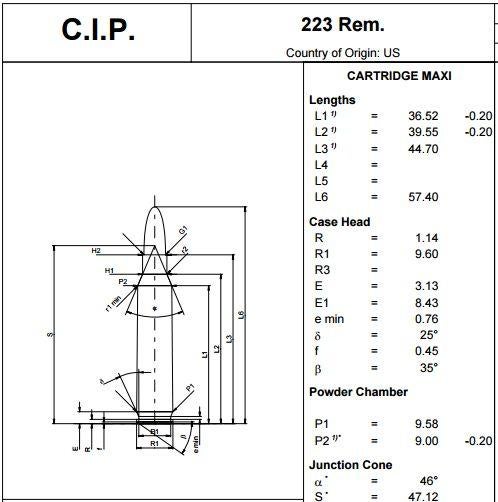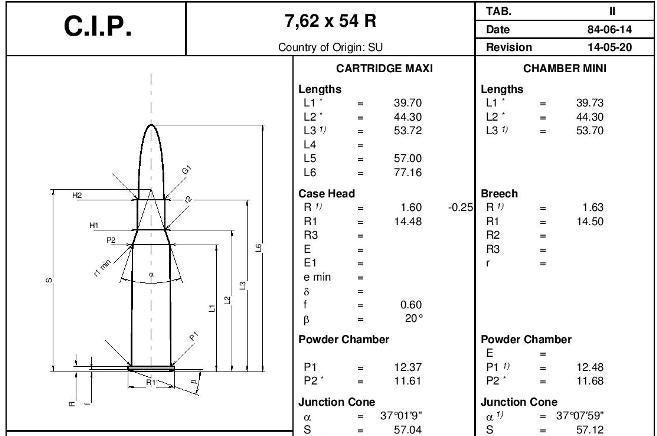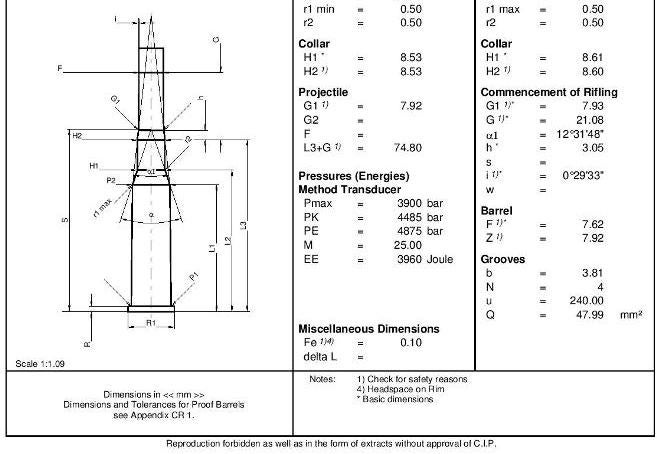I have no doubt that the majority of our readers know about SAAMI (Sporting Arms and Ammunition Manufacturers’ Institute), which sets the ammunition standards, cartridge and chamber drawings etc. These standards are guidelines for manufacturers, but many reloaders, builders, wildcatters and others also use them as a reference. Anyway, if you hear about SAAMI first time, you can see and download the SAAMI cartridge drawings and much more interesting information on their website by clicking here.
So CIP (Commission internationale permanente pour l’épreuve des armes à feu portatives – Permanent International Commission for the Proof of Small Arms) is the equivalent of SAAMI for most of (but not limited to) European countries. CIP was established in 1914 and its headquarters are in Brussels, Belgium. The CIP member countries are Austria, Belgium, Chile, Czech Republic, Finland, France, Germany, Hungary, Italy, Russia, Slovakia, Spain, United Arabic Emirates and United Kingdom.
Compared to SAAMI, CIP’s decisions are not recommendations, but rather have a power of law in the member countries. Although the two organizations cooperate to eliminate the differences between their specs, there are still some differences mainly concerning the pressure measurement and proof testing methodology and equipment used. So, that being said, you should be very careful if you decide to use CIP specs for your project. Keep in mind that CIP specs are not official in the USA, so you’ll be using them at your own risk.
So how then can CIP be interesting for US firearm enthusiasts? How can a US resident find anything useful in CIP, when there is SAAMI? The answer is simply because CIP has a number of cartridge drawings and specifications, which SAAMI does not. And I am not saying that CIP is superior to SAAMI. These are mainly cartridges, that are not popular in the USA but are present at some level. Also, there are cartridges that have recently become widely used in the USA and there are simply no SAAMI specs yet. Many of mentioned cartridges have just been popular in Europe for a longer time and that’s why CIP has them covered. To me, while you can find such drawings in reloading manuals or other sources, those made by CIP are better than those found elsewhere (other than SAAMI).
CIP drawings are a little bit different than that of SAAMI. Instead of having the measurements on the drawing itself, there are letter designations, which then have their corresponding values on a separate table on right side of the actual drawing. Just like in the image below:

I’ve grouped into categories the CIP ammunition specs which can be interesting for fellow firearm enthusiasts in the USA. The cartridge names link to the actual (.pdf) drawings on CIP website. You can also take a look at all the specs by clicking here. So here are those group of cartridges:
1) Military Surplus Ammunition
Everyone knows that military surplus firearms are imported to the USA from all over the world. They are in most cases robust and reliable guns, which come at reasonable prices and with relatively affordable surplus ammunition. There are even US companies offering new, US made guns chambered in those calibers and ammunition manufacturers offering newly made ammo. So among the interesting things in this category, I found the following (which don’t have SAAMI specs): 7.62x54R, 5.45x39mm, 7.62x25mm Tokarev, 6.5x52mm Carcano and 6.5x51mm Arisaka. Click on each cartridge name to see its drawing. Here is the drawing of 7.62x54R as an example:


2) Modern European cartridges
In this category, I’ve included relatively new European cartridges, which gained popularity all over the world. These are 4.6x30mm HK and 5.7x28mm FN. Of course, there are many more, but these two I consider the most interesting.
3) Hunting cartridges
This kind of cartridges are perhaps the most frequent in the drawings. These are cartridges like popular European 9.3×64 Brenneke and 9.3x53R, all sorts of big bore Nitro Express family of cartridges, as well as manufacturer-specific ammunition like those designed by Johann Fanzoj, Rigby, Blaser and others. Interestingly, there are drawings and specifications for probably all Weatherby cartridges including .224, .240, .257, .270, .300, .30-378, .338-378, .378, .375, .416 and .460 Weatherby Magnum cartridges.
4) Old military cartridges
For this category, I was looking for military cartridges that are no longer issued but have historical significance in terms of military firearms development. The cartridges that I chose for this category are 7.92×33 Kurz, 7.62x45mm, 8x51R Lebel, 7.5×55 MAS and 5.45x18mm PSM.
5) Shotgun shells
In CIP specs you can find all kind of rare shotshell drawings including 4ga, 8ga, 14ga, 3.5″ 20ga, 24ga, 32ga. By the way, 32 gauge has a separate Russian version, which is significantly different than the other one. Another interesting aspect is that CIP includes 12 gauge specs with 35mm (1.38″) hull length called 12/35 T and 50mm (2″) hull length called 12/50 SAPL. The latter is a dedicated less-lethal shell. I guess one of them is probably what Aguila Mini Shells are based on.
6) Mystery cartridges
While I was browsing through these drawings, I noticed several cartridges which I never heard of. I also couldn’t find anything on the internet about them. For example, have you heard about 6.5mm Lahoz? It is apparently a French cartridge probably based on 7.62x39mm case with 1.687″ case length and overall length of 2.26″ (equal to 5.56×45 overall length).
Another example is the cartridge called .300 Blacktornado. It looks to be a .338 Lapua necked down to .308 caliber. And there are many other such cartridges there. If the weird ammunition is something you are curious about you’ll find a lot of them in CIP specs.
7) The big guys
I was expecting to see the .50BMG, but was surprised to see 40x46mm grenades!
If the history and development of small arms ammunition are subjects you like to study about, then I hope this article gave you some food for thoughts and you enjoyed it.
 Your Privacy Choices
Your Privacy Choices
